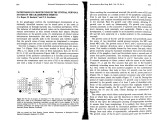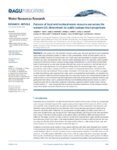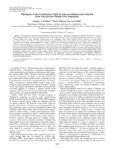|
|
Creator | Title | Description | Subject | Date |
| 451 |
 |
Bastiani, Michael | Pathfinding by growth cones in the central nervous system of the grasshopper embryo | In the grasshopper embryo the morphological development of individually identified neurons can be traced prior to the onset of axonogenesis on through maturity (eg., Goodman and Spitzer, 1979). The behavior of individual growth cones can be characterized in their natural environment as they extend t... | | 1982-06-03 |
| 452 |
 |
Bastiani, Michael | Pathfinding by neuronal growth cones in grasshopper embryo: III. Selective affinity of the G growth cone for the P cells within the A/P fascicle | The growth cone of the G neuron selectively fasciculates upon specific axon bundles in a stereotypic sequence as it navigates through the developing central nervous system of the grasshopper embryo. It turns and extends anteriorly in the contralateral neuropil of the second thoracic ganglion at a s... | Axon; Filopodia; Neuropil | 1984 |
| 453 |
 |
Bastiani, Michael | Pathfinding by neuronal growth cones in grasshopper embryos I. Divergent choices made by the growth cones of sibling neurons | We are interested in how the growth cones of identified neurons navigate in the central nervous system of the grasshopper embryo. The behavior of identified growth cones was observed as a function of developmental time by (i) periodically removing embryos from synchronized clutches of eggs and (i... | Neuropil; Axonal; Cell | 1983 |
| 454 |
 |
Bastiani, Michael | Pathfinding by neuronal growth cones in grasshopper embryos: II. Selective fasciculation onto specific axonal pathways | In the previous paper (Raper, J. A., M. Bastiani, and C. S. Goodman (1983) J. Neurosci. 3: 20-30) we showed that the growth cones of two sibling neurons, the G and C cells, follow the same route in the developing grasshopper neuropil until they reach a stereotypic choice point. Here their growth con... | Neurons; Axons; Neuropil | 1983 |
| 455 |
 |
Bastiani, Michael | Pathfinding by neuronal growth cones in grasshopper embryos: IV. The effects of ablating the A and P axons upon the behavior of the G growth cone | In the companion paper (Bastiani, M. J., J. A. Raper, and C. S. Goodman (1984) J. Neurosci. 4: 2311-2328), we show that as the G growth cone reaches its choice point and turns anteriorly on the A/P fascicle, its filopodia demonstrate selective affinity for the A/P fascicle as compared to the other a... | Labeled pathway; Anterior extension; Fascicle | 1984 |
| 456 |
 |
Coley, Phyllis D. | Patrones en las defensas de las plantas: ? Porque los herbivoros prefrieren ciertas especies? | Patterns of heitmory and plant defenses arc presented lor 47 tree species studied on Barro Colorado Island, Panama. Species growing In comparable microhabitats differ in the rates of herbivore damage by 4 orderi of magnitude. Over 70%QT these between-specles differences in herbivory can be explaine... | | 1987 |
| 457 |
 |
Gesteland, Raymond F. | Pattern of protein synthesis in monkey cells infected by simian virus 40 | After infection of several permanent monkey cell lines by simian virus 40 (SV40), four additional protein bands can be detected by simple sodium dodecyl sulfate-polyacrylamide gel electrophoresis of whole-cell extracts. These bands appear only after the onset of viral deoxyribonucleic acid (DNA) syn... | Monkeys; Simian virus 40; Peptides; DNA, Viral/biosynthesis | 1972 |
| 458 |
 |
Capecchi, Mario R. | Patterns of integration of DNA microinjected into cultured mammalian cells: evidence for homologous recombination between injected plasmid DNA molecules. | We examined the fate of DNA microinjected into nuclei of cultured mammalian cells. The sequence composition and the physical form of the vector carrying the selectable gene affected the efficiency of DNA-mediated transformation. Introduction of sequences near the simian virus 40 origin of DNA replic... | Base Sequence; Cell Line; Genes, Viral; Genetic Vectors; Mice; Microinjections | 1982-11 |
| 459 |
 |
Ehleringer, James R. | Patterns of local and nonlocal water resource use across the western U.S. determined via stable isotope intercomparisons | In the western U.S., the mismatch between public water demands and natural water availability necessitates large interbasin transfers of water as well as groundwater mining of fossil aquifers. Here we identify probable situations of nonlocal water use in both space and time based on isotopic compari... | | 2014-01-01 |
| 460 |
 |
Adler, Frederick R. | Patterns of patch rejection in size-structured populations: beyond the ideal free distribution and size segregation | We examine optimal patch allocation strategies in a population structured by size or some other characteristic. By treating size-specific differences among patches as limiting factors, we create a single framework to analyse foraging for two resources, foraging in the presence of predators and fo... | Foraging-predation trade-off; Optimal foraging; Size structure | 2001 |
| 461 |
 |
Hansen, Mark S.; Coffin, Cheryl M.; Capecchi, Mario R. | Pax3:Fkhr interferes with embryonic Pax3 and Pax7 function: implications for alveolar rhabdomyosarcoma cell of origin. | To investigate the role of the translocation-associated gene Pax3:Fkhr in alveolar rhabdomyosarcomas, we generated a Cre-mediated conditional knock-in of Pax3:Fkhr into the mouse Pax3 locus. Exploring embryonic tumor cell origins, we replaced a Pax3 allele with Pax3:Fkhr throughout its expression do... | Neuroprogenitor; Embryogenesis | 2004-11-01 |
| 462 |
 |
Sekercioglu, Cagan | People skills for the conservation professional | Conservation scientists are increasingly becoming aware of the importance of the human aspects of conservation, and in conservation circles, ‘‘social science'' is the word of the day. There is a rapidly growing social science working group in the Society for Conservation Biology and it is hard t... | | 2008-01-01 |
| 463 |
 |
Olivera, Baldomero M.; Gray, William Robert | Peptide toxins from Conus geographus venom | The biochemical characterization of three highly toxic peptides from the venom of the marine snail Conus geographus is described in this report. These peptides cause their potent activity by inhibition of the postsynaptic terminus of the vertebrate neuromuscular junction. The relatively small size o... | Conus geographus; Venom; Conotoxins; Neurotoxins | 1981 |
| 464 |
 |
Capecchi, Mario R. | Personal view of gene targeting | Gene targeting provides the means for creating strains of mice with mutations in virtually any gene.1 First, the desired mutation is introduced into a cloned copy of the chosen gene by standard recombinant DNA technology. The mutation is then transferred to the genome of a pluripotent mouse embryo-d... | | 1995 |
| 465 |
 |
Coley, Phyllis D.; Kursar, Thomas A. | Pests vs. drought as determinants of plant distribution along a tropical rainfall gradient | Understanding the mechanisms that shape the distribution of organisms can help explain patterns of local and regional biodiversity and predict the susceptibility of communities to environmental change. In the species-rich tropics, a gradient in rainfall between wet evergreen and dry seasonal forests... | Drought tolerance; Herbivory; Panama; Pathogen attack; Rainfall gradient; Tree distribution; Tropical forests | 2009 |
| 466 |
 |
Hughes, Kelly T. | Phase variation in Salmonella: analysis of Hin recombinase and hix recombination site interaction in vivo | The bacteriophage P22-based challenge phase selection was used to characterize the binding of Salmonella Hin recombinase to the wild-type hixL and hixR recombination sites, as well as to mutant and synthetic hix sequences in vivo. Hin recombinase binds to the hixL or hixR recombination sites and rep... | | 1988 |
| 467 |
 |
Bohs, Lynn A. | Phylogenetic relationships among the "spiny solanums" (Solanum subgenus Leptostemonum, Solanaceae) | Species of Solanum subgenus Leptostemonum comprise almost one third of the genus and are distributed worldwide. Members of this group are defined by their sharp epidermal prickles; thus, they are commonly referred to as the ˜spiny solanums." This subgenus includes a number of economically important... | Granule-bound starch synthase gene; GBSSI; Heterandry; ITS; Leptostemonum; Solanum; trnS-trnG; Waxy | 2006 |
| 468 |
 |
Bohs, Lynn A. | Phylogenetic relationships in Solanum (Solanaceae) based on ndhF sequences | A phylogenetic analysis was conducted using sequence data from the chloroplast gene ndhF. Sequences were obtained from 25 species of Solanaceae, including 18 species of Solanum representing five of the seven conventionally recognized subgenera. | Solanum; ndhF | 1997 |
| 469 |
 |
Bohs, Lynn A. | Phylogenetic relationships in solanum section Androceras (Solanaceae) | The Leptostemonum clade of Solanum contains approximately 350-450 species, including the cultivated eggplant, S. melongena. This clade is characterized by the presence of prickles and apically attenuate anthers. Solanum section Androceras, the focus of this study, is a group of ca. 12 species belon... | | 2010-12-01 |
| 470 |
 |
Bohs, Lynn A. | Phylogeny and biogeography of the Canarian Solanum vespertilio and S. lidii (Solanaceae) | The endemic and rare Solanum vespertilio and S. lidii from the Canary Islands are notable in being andromonoecious, self compatible, highly heterandrous (with short >reward= anthers and one very long >pollination= anther), and bearing strongly zygomorphic corollas. Solanum vespertilio flowers are a... | Solanum vespertilio; Solanum lidii; Leptostemonum; tnT-F region; granule-bound starch synthase gene; GBSSI; Andromonoecy; Hererandry; Enantiostyly | 2006 |
| 471 |
 |
Bohs, Lynn A. | Phylogeny and provisional classification of the Solanaceae based on chloroplast DNA | A phylogenetic analysis of the Solanaceae based on chloroplast DNA variation is presented. Restriction site maps were determined for 79 species (52 genera) for 11 restriction enzymes. | rbcL; ndhF; Chloroplast DNA | 1999 |
| 472 |
 |
Bohs, Lynn A. | Phylogeny of Balsamorhiza and Wyethia (Asteraceae: Heliantheae) using ITS, ETS, and trnK sequence data | Balsamorhiza and Wyethia together comprise 24 species native to western North America. All species in the two genera are perennial herbs with large taproots and chromosome base numbers of x = 19. The species of Balsamorhiza have exclusively basal leaves while the species of Wyethia have cauline leav... | Balsamorhiza; Wyethia; Asteraceae; Engelmanniinae; nuclear ribosomal DNA | 2007 |
| 473 |
 |
Bohs, Lynn A. | Phylogeny of the carolinense clade of solanum (Solanaceae) inferred from nuclear and plastid DNA sequences | The large and economically important genus Solanum contains ca. 1,400 species distributed worldwide. One of the 12-14 major clades identified in the genus is the Leptostemonum clade, or the "spiny solanums." Previous molecular phylogenetic studies have identified 14 major clades in the spiny solanum... | | 2014-01-01 |
| 474 |
 |
Bohs, Lynn A. | Phylogeny of the Cyphomandra clade of the genus Solanum (Solanaceae) based on ITS sequence data | 13 major clades can be recognized within the genus Solatium (Solanaceae) based on chloroplast DNA sequence data. One of these is the Cyphomandra clade, which includes about 50 neotropical species. These have traditionally been placed into two or three sections: S. section Pachyphylla (formerly recog... | Cyphomandra; ITS; osmophores; self-incompatibility; Solanum | 2007 |
| 475 |
 |
Goller, Franz | Physiologically driven avian vocal synthesizer | In this work, we build an electronic syrinx, i.e., a programmable electronic device capable of integrating biomechanical model equations for the avian vocal organ in order to synthesize song. This vocal prosthesis is controlled by the bird's neural instructions to respiratory and the syringeal mot... | | 2010-03 |

























